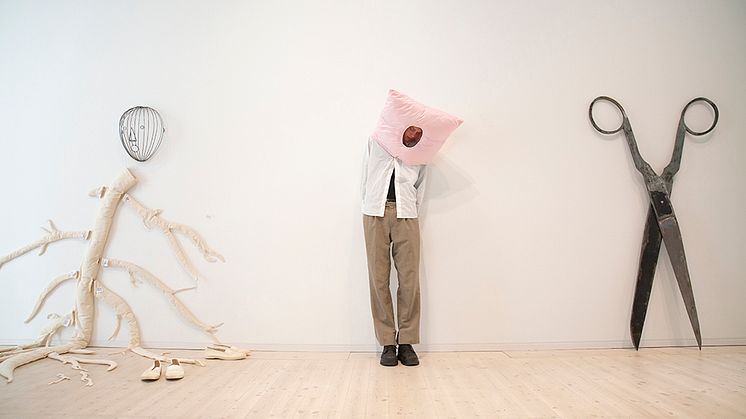
Press release -
Eva Koťátková / What Does a Turtle Feel Through the Carapace?
Empathy and the ability to understand the situation of others is the theme of Czech artist Eva Koťátková’s exhibition, which opens at Bildmuseet on April 8. The central work is a two-part installation, one of which is shown in the artist’s solo exhibition at Bildmuseet and the other in parallel as part of ARS22 at Kiasma in Helsinki.
Welcome to the press preview on Thursday, April 7 at 10:00 (RSVP). Curator Brita Täljedal will present the exhibition. Press images.
Eva Koťátková’s dramatic stagings are reminiscent of dreamy states and curio cabinets with references to both historical images and contemporary culture. With sculpture, collages, drawings, text, sound and suggestive scenography, she examines what evokes emotions and how they help us connect with each other beyond categorical subdivisions and hierarchies.
The exhibition’s central work is a giant talking bush surrounded by beds. There, visitors can lie down and listen to stories of a fish out of water, an exotic bush torn out by the roots, a body which didn’t grow yet, or a spider arousing disgust.
Koťátková takes an interest in social structures, like the relationship between the collective society and the individual. Her surreal stagings portray fear and vulnerability, often from the perspective of children or elders. Childhood, learning, and school are recurring themes. Her exhibition at Bildmuseet sees the artist as a cross-species classroom. In this learning place, she invites visitors of all ages to share experiences and dreams together.
The exhibition includes an educational programme with interactive tours and workshops designed in collaboration with the artist. For workshop participants, she has created costumes to facilitate the understanding of others: a fish costume, a bush costume, and a spider costume, for example.
Eva Koťátková was born in 1982 in Prague, Czechoslovakia, where she still lives and works. She has exhibited in leading museums, art institutions and biennials worldwide. She will participate in this year's documenta15. The exhibition at Bildmuseet will present the artist in Sweden for the first time.
Eva Koťátková / What Does a Turtle Feel Through the Carapace? is produced by Bildmuseet. The exhibition’s central work is created as a whole with two parts displayed simultaneously: one at Bildmuseet and the other at ARS22, Kiasma’s display of international contemporary art. The collaboration between Bildmuseet and Museum of Contemporary Art Kiasma/Finnish National Gallery is initiated and supported by the Swedish-Finnish Cultural Foundation.
Exhibition opening during Bildmuseet’s Art Friday on April 8, at 17:00-21:00. The artist will be presenting her exhibition. Workshop and bar. Guest DJ: Heaven Small. Welcome!
Contact
Brita Täljedal, museum curator
brita.taljedal@bildmuseet.umu.se, +46 90-786 7714
Helena Vejbrink, press contact
helena.vejbrink@bildmuseet.umu.se, +46 90-786 9073
Related links
Topics
Categories
Housed in an acclaimed building at the Umeå Arts Campus, right next to the Umeå Academy of Fine Arts, Umeå Institute of Design and Umeå School of Architecture, Bildmuseet is a part of Umeå University – one of Sweden's largest institutions of higher learning with over 36000 students and 4,000 employees. It is a multifaced university where studies and research within the creative realm make up an important part of the university's cornerstone.


